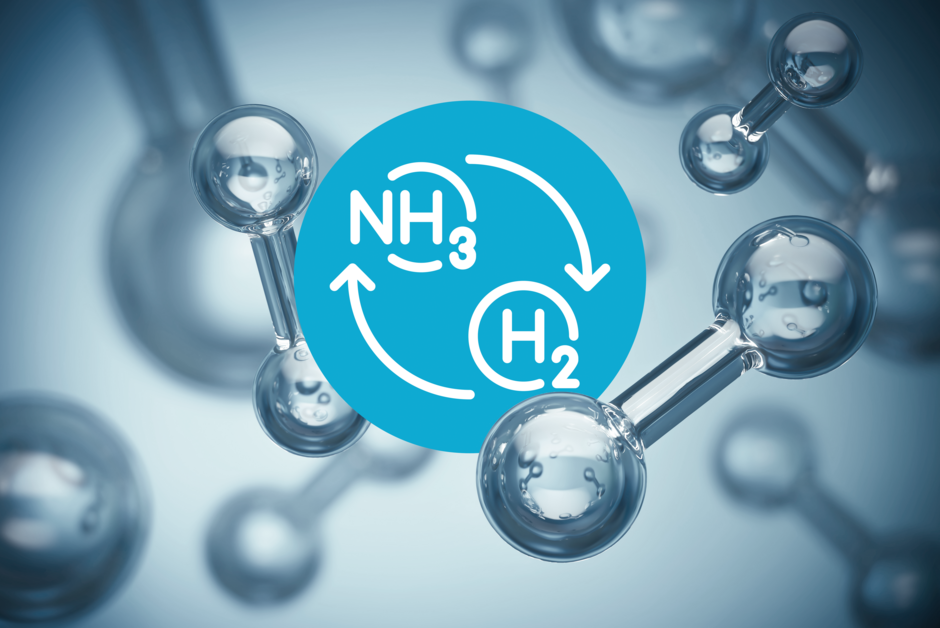State graduate program hydrogen and hydrogen derivative ammonia
The aim of the graduate program hydrogen and hydrogen derivative ammonia is to investigate economic, ecological, systemic, safety-related and social aspects along the entire life cycle of the hydrogen derivative ammonia. This includes the synthesis, utilization and hydrogen recovery.
The graduate program was applied for by Clausthal University of Technology, Leibniz University Hannover, Braunschweig University of Technology, University of Oldenburg, in cooperation with the German Aerospace Center (DLR) - Institute of Engineering Thermodynamics, the Institute for Solar Energy Research in Hameln (ISFH) and the Federal Physical-Technical Institute (PTB).
The program's speakers are Prof. Dr.-Ing. Thomas Turek (TU Clausthal) and Prof. Dr. Mehtap Özaslan (University of Hamburg). The program's coordinator is Prof. Dr.-Ing. Sabrina Zellmer (TU Braunschweig).

Goals, methods and innovation areas
Motivation and research approach
In current economic discussions about energy, ammonia plays an important role alongside green hydrogen. Ammonia can be liquefied at low pressures, making it easy to transport and thus an efficient hydrogen carrier due to its high amount of hydrogen. In addition, ammonia is synthesized carbon-free from water and air, allowing it to be produced anywhere in the world without the need for an additional carbon source and shipped globally. Therefore, ammonia will become of great importance for Germany and especially the importing state of Lower Saxony in the future.
Ammonia is then either used directly as a chemical or energy source or is cracked back into its elements, recovering hydrogen in the process. All methods of using and converting ammonia yield nitrogen and water again, thus closing global material cycles. It is therefore necessary to consider the entire ammonia value chain from a technical, economic, ecological, systematic and safety perspective.
Innovation areas
| Name | Research approaches |
| I. Synthesis | With regard to NH3 synthesis, issues concerning the dynamic operation of the Haber-Bosch process and the early state electrochemical ammonia synthesis will be examined. |
| II. Direct use | The direct use of ammonia includes the combustion of ammonia and H2/NH3 mixtures as well as its electrochemical conversion to generate electrical energy in various high- and low-temperature fuel cell systems. |
| III. H2 recovery | However, electrochemical cells can also be used to recover hydrogen. The chemical-catalytic decomposition of NH3 is also considered. |
| IV. Cross-sectional technologies | Comparing the chemical-catalytic and electrochemical processes allows us to derive important techno-economic and social requirements for the respective technologically less developed routes. |
Innovation area I - Synthesis
Conventional reactors used to produce ammonia via the Haber-Bosch process must be operated in a steady state condition and are therefore not suitable for the integration of fluctuating renewable energy sources. Therefore, novel polytropic (cooled) reactor concepts are required, which have clear advantages for load-flexible and dynamic operation. Another promising production method is electrochemical synthesis from nitrogen, which is still at an early stage of development. In the long term, this process could represent an alternative for electrochemical cells under much more moderate reaction conditions.
Innovation area II - Direct use
As a hydrogen and energy carrier, ammonia is easy to transport and store. At the destination or at the required time of utilization, NH3 can either be used directly or converted back into hydrogen. This innovation area specifically examines direct energy utilization through two types of conversion: (a) combustion to utilize thermal energy and (b) use in fuel cells to generate electricity directly.
Innovation area III - H2 recovery
Cracking requires novel, active catalysts whose kinetics must be analyzed in order to design suitable reaction systems. Since a complete conversion of NH3 is often not accomplished, the treatment of gas mixtures is also to be investigated.
Innovation area IV - Cross-sectional technologies
Due to its widespread use as a basic chemical for nitrogen-containing compounds, there is extensive experience for the transportation, safe handling and also business models for ammonia. However, this does not yet include the production of green ammonia or the use of this product as an energy source.